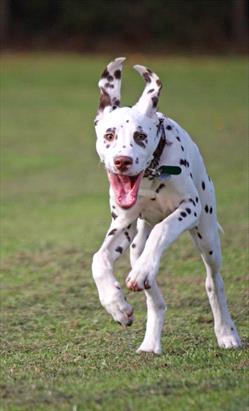As I watched the video my friend sent me, I saw a reactive dog, named Frankie, lying down in front of his human. The owner was trying to reward quiet, calm behavior while other dogs were far away. Frankie fidgets and keeps moving, gets up and then lies back down, but he’s focused on his owner much of the time. The problem? The owner’s timing of rewards is way too slow to effectively reward a calm down-stay. It’s like the owner is moving at the speed of The Lawrence Welk Show when the speed the dog wants is along the lines of MTV. As a result, the owner sometimes rewards a down and sometimes rewards Frankie as he starts to get up or even after he’s stood up. Ideally, the owner would be fast enough to reward him for lying down every 3 seconds or so at first and while he’s still lying down. Once Frankie starts relaxing at that rate, the owner would slow down to, say, 5-second intervals before increasing to longer intervals. Or the owner could, of course, just get a Treat & Train® where the intervals have been determined through scientific study and the rewards are delivered in a location that’s perfect for a dog that is lying down.
In the midst of this dog’s fidgety performance, the owner states, “Frankie is hard to train because he’s very operant.”
“Hmm…,” I think. “What does that mean? By “very operant” does the owner mean the dog is so fast that she can’t get her timing right? Or just that the dog tries a bunch of different things?” If I hadn’t seen the video I would be completely clueless as to what the owner meant. Why? Because using this term to describe the dog actually makes no sense. It’s like calling a dog dominant as a personality trait when what one means is the dog is aggressive, unruly, energetic, or the dog misbehaves, since dominance is a relationship, not an individual trait.
Am I The Only One With This Pet Peeve?
You might think the inappropriate use of the word “operant” to describe a dog is my pet peeve, but it turns out that it drives others behavior scientists crazy, too.
Here’s what Bob Bailey, former General Manager of Animal Behavior Enterprises—a company that showcased the science of operant conditioning by training over 14,000 animals of 140 species for television, amusement parks, sales conferences, military operations, and behavior research—says:
Let’s see – a sleeping dog is probably not exhibiting lots of operant behavior. Most certainly a dead dog does little that would be considered operant. But, the rest of the time, a live and awake dog will exhibit lots of operant behavior- that is, behavior that has been influenced by consequence, whether reinforcing or punishing. I think those using the term “operant dog” simply don’t know the real meaning of the word. Perhaps the word “operant” has a certain market value now and it is being exploited.
Dr. Eduardo J. Fernandez, a professor in the Psychology Department (Animal Behavior Program) at University of Washington and one of my collaborators on the research testing the operant conditioning protocol for the MannersMinder®, agrees.
This use of “operant” to describe a dog is odd. Skinner and most behaviorists would point out one very clear problem with this use of “operant” as an animal-describing adjective; operant terms, such as “reinforcement”, “punishment”, and “operant” itself, describe behaviors, not organisms!
It seems like what people are trying to describe, both good and bad, is an organism that will cycle through a large repertoire of behaviors in the hopes of being rewarded for something. In both cases, it would probably be more behaviorally accurate to simply say, “My dog offers a lot of behaviors!” Calling the dog “operant” is about as unclear as saying “my dog is very voluntary.” And really, when it comes to trying to describe any organism, it’s always best to use clear, observable terms that describe the animal’s behavior, rather than some non-observable quality that the animal supposedly has!
Fernandez knows the importance of describing animal behavior in clear cut terms because he spends a large part of his time developing programs to measure behavior in animals in zoos in order to determine where changes to care may be needed.
A Third Behaviorist Weighs In
Another well known behaviorist, Dr. Susan Friedman, a psychology professor at Utah State University and owner of www.behaviorworks.org, states:
“That phrase is irksome to me, too.” She also points out another irksome phrase. She states, “Another version I’ve heard too often among dog trainers, ‘He can’t learn now, he’s not operant.’”
Dr. Friedman, who teaches a highly rated online course for animal behavior professionals, continues,
I think it is just a new example of the explanatory fiction that an animal’s behavior 1) resides inside the animal, and 2) is independent of the conditions in which it behaves. Both of these ideas are not to the goal of behavior change because they alleviate the trainer of responsibility for what the animal does (which is exactly the opposite of what we want).
In other words, Friedman feels this inappropriate descriptor serves as an excuse for people to explain why they have trouble training their dogs. Blame the dog for moving too fast or offering too many behaviors, instead of the owners blaming their bad timing or rate of reinforcement, inappropriate shaping steps, or other technique-related factors.
It’s Unanimous!
The vote is in. Scientists and others who value accurate definitions and descriptors can’t stand the misuse of the word “operant” to describe how a dog behaves. No doubt Skinner would be irked, too.
So what terms should you use instead? Just describe the behavior you see. If you mean the dog moves quickly and cycles through a lot of behaviors voluntarily you might use Fernandez’s, ”My dog offers a lot of behaviors.” If you mean something different, describe what you’re talking about.



